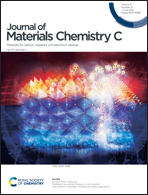Printed solid state electrolyte carbon nanotube thin film transistors for sub-1 V fully printed flexible CMOS inverters†
Abstract
In this paper, we reported the realization of fully printed flexible ultra-low voltage single-walled carbon nanotube (SWCNT) thin film transistors (TFTs) and CMOS inverters at temperatures lower than 170 °C using ionic liquid (IL) crosslinked-poly(4-vinylphenol) as the composite solid state electrolyte dielectric layer. Optimized fully printed p-type SWCNT-TFTs exhibited good performance with an average field effect mobility of 6.6 cm2 V−1 s−1, an ON/OFF ratio above 106, a small hysteresis (100 mV), and a subthreshold swing (SS) as low as 95 mV dec−1 at low operating gate voltages (±0.75 V). Converting the polarity from p-type into n-type using epoxy amine inks enables us to fabricate fully printed low-voltage SWCNT CMOS inverters. The power dissipation could be decreased by decreasing the number of printing cycles of sc-SWCNT inks in device channels. The peak power dissipation of the resulting flexible CMOS inverters could reach 6 nW and VDD is down to 0.5 V along with a voltage gain of 10 and a maximum noise margin of 0.28 V (∼56% of VDD/2). To the best of the authors’ knowledge, the voltage gain, noise margin and static power consumption values achieved in this work are the best values reported to date in the literature for fully printed SWCNT inverters.



 Please wait while we load your content...
Please wait while we load your content...